North Minneapolis Greenway
It turned out that the most interesting finding of my Minneapolis trip was similar to that from Austin; a bike facility sitting right in the middle of a battle over identity politics. In Austin the issue was exclusion; in Minneapolis, it’s disruption.
North Minneapolis is a low-income area that has been losing population, and becoming poorer and less white, for 30 years. It’s a majority-minority district, with African-Americans (43%) being the predominant race. The typical hallmarks of disinvested ethnic districts are found there; decaying infrastructure, fewer trees, poorer schools, and higher crime rates than the rest of the city.
Inspired by the best bike facility in town (the Midtown Greenway, an impressive rails-to-trails conversion of a multi-track trenched railroad), a number of groups have been working for five years to convert some of the low-traffic street infrastructure of North Minneapolis into a greenway. The initial proposal would restrict auto traffic and reclaim part of the roadway over a six-block stretch to link two North Minneapolis parks.
There have been a number of community outreach events over the years, including an Open Streets event in 2015. The publicity around the development has stressed the importance of community engagement. There are four different community engagement reports, all of which have shown majority support for the greenway among residents on and near the route.
It so happened that installation of the demonstration greenway (road paint and movable street furniture) was finished just a few days before my arrival in Minneapolis. I got to chat with Alexis Pennie (one of the advocates for the project) about his experience with the grand opening, and I went up and rode the Temporary Greenway myself.
The whole thing makes me a little sad.
The intentions of the advocates are good. They really want to make the neighborhood better, and they really believe that creating an innovative bike and pedestrian facility will help. (Leaving aside the context, I tend to agree with them). And they have really worked to do community outreach; there are four different survey reports, all of which show significant majorities of people in the neighborhoods “support” or “strongly support” the greenway.
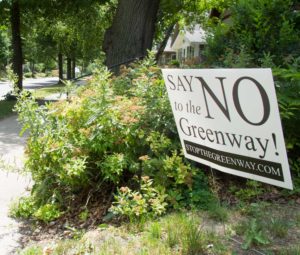
About a quarter of the houses had “NO’ signs on the closed blocks.
But they’ve not succeeded at getting the oppositional residents on board. On the contrary, the opposition has become more organized and strident over time, and the gap between advocate and opponent appears to have grown. Maybe a quarter of the houses on the demonstration stretch have “Say NO” signs on the lawn. (A smaller number have “Support the Greenway” signs). Opponents are maintaining a Stop The Greenway blog which displays a high level of anger and vitriol. And, frankly, it sounds like they have some valid points about the way the project has been approached. A danger for those with power and privilege is to assume that the futility of full consensus is sufficient reason to dismiss the concerns of the minority, and it seems to me like that’s what’s happened here. I don’t think the city has lived up to the aspirations of the video above.
It makes me sad because the advocates are probably right. The neighborhood probably would be a better place with better streets, and resident concerns about parking and fire truck access probably can be addressed on the margins. But the residents of places like North Minneapolis have decades of experience of the city neglecting them except to occasionally put in a big new infrastructure project which screws up the neighborhood. They’re justifiably skeptical of the motivations of the city, and angry that a project that they don’t value is getting funded when many projects they’ve asked for appear to have been neglected over the years.
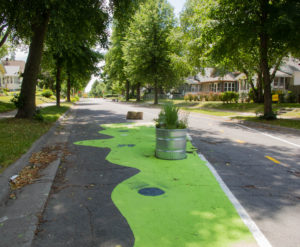
North Minneapolis temporary greenway
I hope that some experience the demonstration project can bridge the gap, but I’m not optimistic. The authors on the Stop the Greenway blog make a big deal how only residents of North Minneapolis or the greenway route should have standing to comment. There’s a lot of “us” vs. “them” language and a whole bunch of distrust. It’s going to be difficult to break through those identity issues, even with the best of intentions. And I don’t think the project itself is compelling enough to make it happen. On my way to the airport I described the facility to my Uber driver, who opined, “There’s no way that’s going to work in a war zone.”

 Previous Post
Previous Post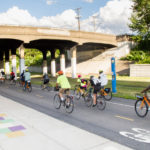 Next Post
Next Post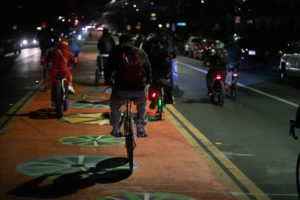
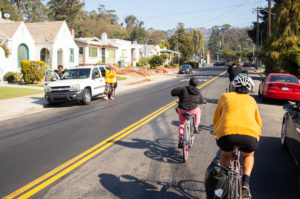
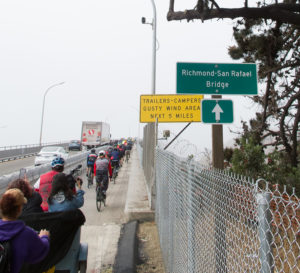

[…] People naturally want to emulate successful facilities, but Charlotte and North Minneapolis don’t have abandoned grade-separated rail lines to repurpose for cycling, so the facilities […]
[…] organizations, but place-making as an explicit goal is a little unusual. Certainly projects like North Minneapolis and Little Sugar Creek have place-making components, but the dialog tends to be more about safety […]
[…] it look like to build community power through cycling? It definitely doesn’t look like the North Minneapolis Greenway or Southern Walnut Creek Trail projects. I think it looks a lot like what Rich City Rides and the […]
[…] my field work this manifested as a planning disaster in North Minneapolis, as advocates forced through a neighborhood greenway which later had to be […]